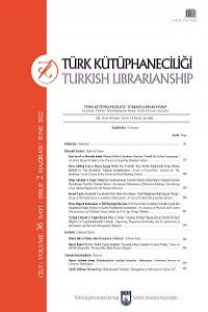Nöro-Bilgi Biliminin Bireylerin Bilgi Gereksinimlerinin Belirlenmesindeki Yeri ve Bilgi Erişim Süreci
Bireylerin bilişsel yapılarındaki farklılıklar ve teknolojiye uyum sürecinde yaşadıkları farklılık nedeniyle kullanıcılar bilgi erişim sürecinde farklı arama davranışları gösterebilmektedir. Bu nedenle bu çalışmada, bilgi erişim sürecinde kullanıcıların bilgi arama davranışlarının değerlendirilmesinde kullanıcı sistem etkileşimine odaklanan nöral ve bilişsel değerlendirme yöntemlerinin kullanılabileceği vurgulanmıştır.
Anahtar Kelimeler:
Nöro-bilgi bilim, Bilgi gereksinimleri, Bilgi erişim süreci
The Place of Neuro-Information Science in Defining The Information Needs of Individuals and Their Information Retrieval Process
Due to the differences in the cognitive structures of individuals and the difference they experience in the process of adaptation to technology, users may show different search behaviors in the information retrieval process. Therefore, in this study, it has been emphasized that neural and cognitive assessment methods focused on system-user interaction can be used in the evaluation of information seeking behaviors of users in the information retrieval process.
Keywords:
Neuro information science Information needs, Information retrieval, neural information retrieval,
___
- Carter, B. T. and Luke, S. G. (2020). Best practices in eye tracking research. International Journal of Psychophysiology, 155, 49-62.
- Düzgün, A. Electrophysiological measurements of brand perception in neuromarketing by means of brain oscillations and electrophysiology (EEG). Postgraduate Thesis, İstanbul Kültür University, İstanbul, 2016.
- Ferebee, S. and Davis, J. W. (2011). Persuading library use in technologically structured individuals. Library Hi Tech, 29 (4), 586-604.
- Gwizdka, J., Moshfeghi, Y. and Wilson, M. L. (2019). Introduction to the special issue on neuro‐information science. Journal of the Association for Information Science and Technology, 70 (9), 911-916.
- Moshfeghi, Y. (2021) Neura search: neuro science and information retrieval. CEUR Workshop Proceedings, Proceeding Book, 193-194.
- Weilenmann, A. K. (2021). Information Science and Neuroscience -an interaction?. ISIC. DOI: 10.13140/RG.2.2.31925.88802. Accessed March 4, 2021.
- Başlangıç: 1952
- Yayıncı: Türk Kütüphaneciler Derneği
